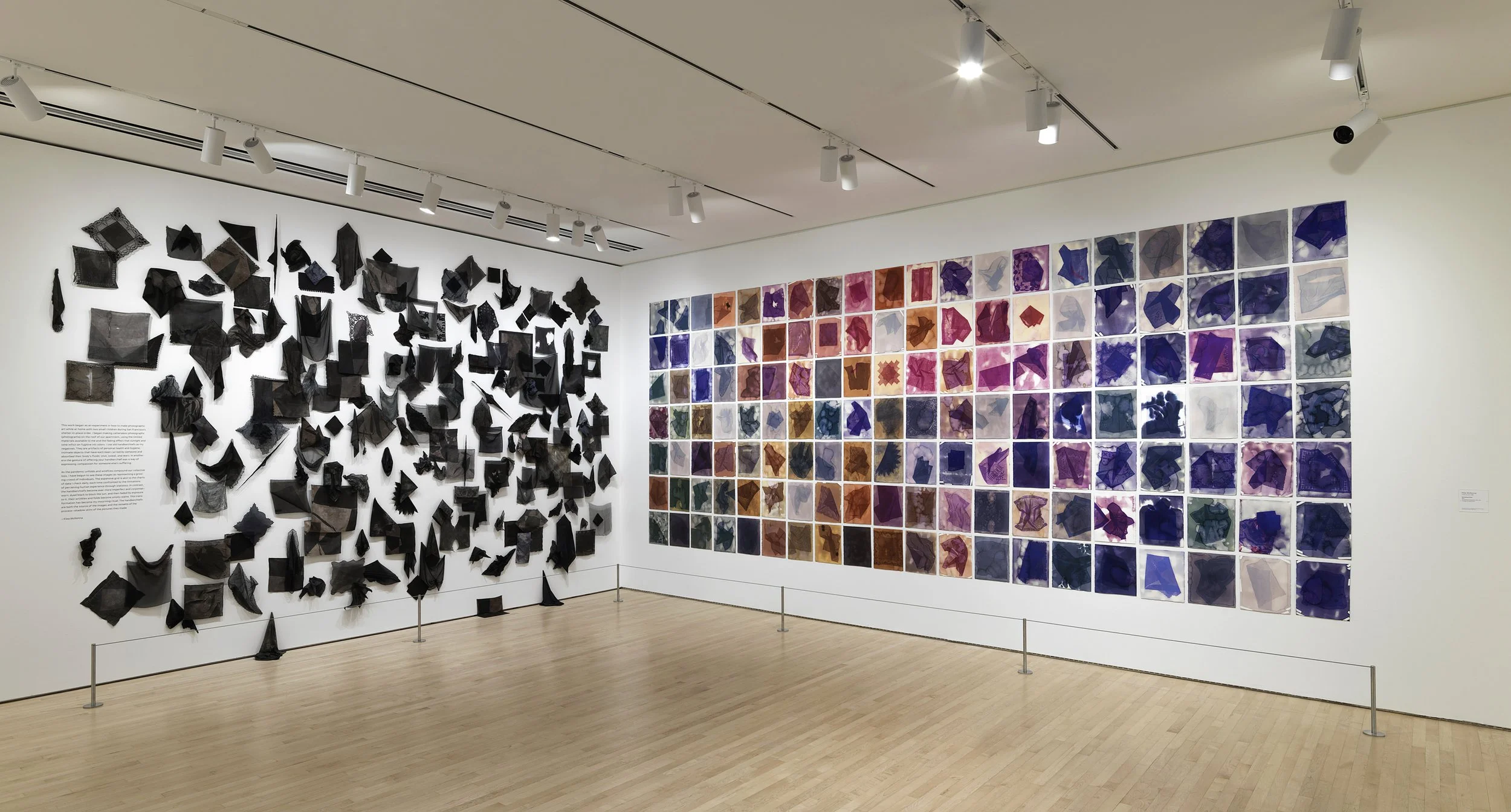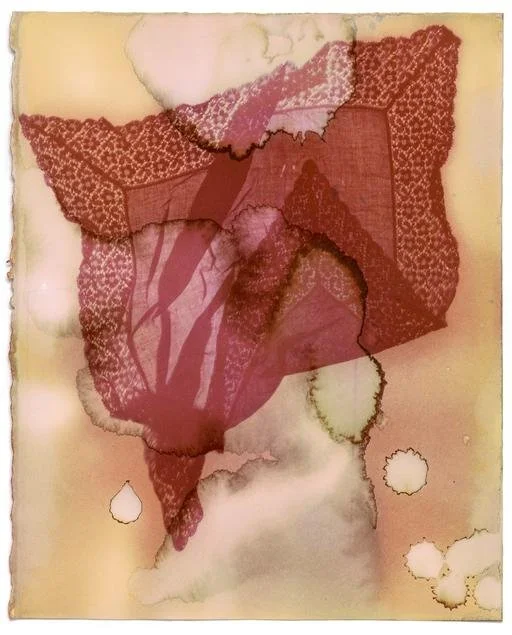
Images courtesy of the artist. Portrait (Blue Earth) (left) and Portrait (Hybrid 1) (right) from the series "How Forests Think" Analog chromogenic photograms. 60x32 inches each, 2015.
FEBRUARY 17TH, 2022
PHOTOGRAPHY WITH AN EDGE is a periodical feature showcasing NFT artists working with photographic practices that defy or challenge the common definition of a photograph. We are here to explore and celebrate these more exotic forms of photography and the free mixture of old and new, art and science, analog and digital employed in the exploration of the limits and possibilities of light, chemistry, and bits.
Klea McKenna is known for her cameraless photography and her innovative use of light-sensitive materials. Much of her work uses analog techniques she has invented, such as photographic rubbings and fugitive ink photograms. She is the daughter of renegade ethnobotanists Terence McKenna and Kathleen Harrison, who raised her and her brother in Hawaii, Northern California and on the road. This unconventional upbringing steeped her in magical thinking and a deep awareness of the animate landscape around us. Her unique perspective is evident in her experimental artwork and the way she draws out the histories and patterns within her subjects. Klea’s work has been shown internationally and is held in numerous museums and public collections. She is currently working on a monograph of her photographic work, which will be published by Saint Lucy Books in 2022.
I was initially drawn to Klea’s work when I discovered her photograms on Foundation.app (see images above). From the collection title, “How Forests Think” to the lovely images in the collection, to the absorbing descriptions Klea gives to each piece, I was smitten. In one description, Klea writes,
There is a sound that comes from the forest some nights. It has always been there, though it drifts in and out of human audibility. When I was a kid, my Mom named it; she called it “The cocktail party in the woods.”
The luscious color and lovely detail of Klea’s photograms drew me in and I found myself listening for that forest sound, ready to join that cocktail party in the forest she had made.
Traveling from Klea’s Twitter profile to her work on Quantum.art, I found her series, No Feeling is Final, equally compelling. Here, Klea’s photograms are of manmade objects as she confronts the collective and personal loss we’ve faced as a result of the ongoing global pandemic.

Images courtesy of the artist. "No Feeling is Final" - Installation of 140 Fugitive ink photograms and 200+ vintage handkerchiefs. Watercolor ink on rag paper, sunlight, time, found textiles, fabric dye.2020

"No Feeling is Final" - Detail.
My grandmother had a trunk in which she kept her most precious possessions - towels given to her as Christmas gifts that she found “too pretty to use”, and similar treasures. In that trunk were embroidered handkerchiefs of fine weave. Klea’s photograms took me immediately back to the few times I was allowed to open the trunk and carefully explore its contents. Looking at them I could feel my grandmother’s presence and recall the distinctive smell of objects laid away. I confronted the loss, not of the pandemic, but of time. And is that not the mark of a powerful work of art - to touch our hearts and our minds, to put us in touch with our emotions, our memories, our deepest selves?
Let’s let Klea tell us more.
Can you describe your process?
My primary medium is cameraless photography; direct light-to-paper images are made through analog light sensitivity. I have pushed this antiquated medium to do many jobs it was not designed for, thereby innovating new techniques and ways to interpret our environment. I use these techniques to reanimate artifacts from the material culture and the natural world. My subjects (Tree stumps, giant leaves, found clothing, hand-made textiles and old paintings, etc.) bear the marks, flaws, stains, fingerprints and damage that accumulate through time, growth, trauma, devotion and contact with our human bodies. Most of my recent work is what I call “photographic reliefs.” In the darkness, I emboss these charged objects into photographic paper then cast light across the resulting textures. This process subverts photography’s intended use by making touch more primary than sight and generates images made by pressure that contain a confounding blend of evidence and fiction. I then add color to these embossed photograms with toners, inks and fabric dye. Many of these pieces are very large so I develop them vertically, by painting on and washing off the photochemistry, this furthers the nuance and imperfections of each piece.
Where do you look for inspiration?
For many years I worked with subjects from nature, natural elements and things found in the landscape, so my primary inspiration was my own sensory experience of places. In the last few years, much of my inspiration has come from archeology and speculative fiction. Trying to understand the present by imagining that I am looking back from a different future. I have also always been inspired by dance and vernacular movement – the way our bodies leave marks on the world around us and are also marked by it. Some favorite artists are Pina Bausch, Gordon Matta-Clark, Ana Mendieta…
What started you on this journey?
Which journey? There are so many. I got into photography when I was around thirteen and I guess I never looked back. I was also a dancer, but photography became the way I could interpret the world. I made “straight photos” and shot documentary images with cameras for years and then when I was around 28 and in graduate school, I became frustrated with the lack of transformation in that process. I was skilled at it, so the result became too predictable for me. I was craving the magic that had been present in this medium when I was learning photography as a teenager. So, I began to devise ways to intentionally lose control over the process so that I could feel the risk/thrill/surprise/disappointment and joy of making something unexpected. This period involved doing a lot of silly experiments and making some pretty bad work, but it helped me let go of control so that I could find a new, more individual voice. Eventually, I turned the corner and wanted to articulate again through my medium, but by then I had let go of the camera and fallen in love with photograms and light and paper. So here I am 13 years later and still really in love and entangled with this medium.
What prompted you to expand your work into the NFT realm?
I’ve spent my education and career in the art world and there are things I love about it (such as the intellectual curiosity and critical discourse) but the reality is that it is financially unsustainable for most artists unless they already come from wealth and privilege or have another income stream. Even artists who appear successful from the outside (creatively, curatorially, critically) are often unable to make ends meet because the structure is set up to benefit collectors, dealers and auction houses, not artists. Over the last year my husband encouraged me to tune-in to what was happening with NFTs. I resisted for a long time (I am a very analog girl) and then I finally decided it was time to embrace my own adaptability and join the future. So, my initial interest was in how the advent of NFTs (which have resale royalties built-in) might change the labor dynamics for artists and hopefully even put pressure on the physical art world to embrace resale royalties as well. I see it as absolutely necessary to have a more diverse and creative culture that is not just for the elite. And now that I have gotten into it, there are a lot of unexpected connections and aspects of the scene that I am enjoying.
Where do you expect your work to take you in the next year?
I’m currently working on 3 fronts:
I’m making work for a solo show at Euqinom Gallery in San Francisco, which will open in May. This work is hybrid, they are large, analog B&W photograms which are then painted with fabric dye. There may even be some NFTs in the show.
My first monograph will be published by Saint Lucy Books in September. It includes seven years of my work and is called “Witness Mark” and will have some essays by wonderful women art writers.
And lastly, I’m continuing to navigate the NFT realm. What I am most excited about there is to make work with this new format in mind rather than minting previous work. It will still be rooted in analog photography, but I am curious to see which ideas are possible in this digital format that aren’t possible as physical objects. This feels like my growing edge right now.
Where can people find your work?
I have two bodies of NFT work out there. One with Quantum and one on Foundation:
No Feeling is Final by Klea McKenna
How Forests Think | Foundation
The IRL galleries I’m represented by are:
EUQINOM Gallery in San Francisco
Gitterman Gallery in New York
My own website is www.kleamckenna.com. You can also find me on Twitter at @klea_mckenna) and Instagram at KLEAM c KENNA (@klea_mckenna).
